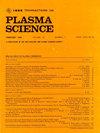Load Characteristic Analysis of Dielectric Barrier Discharge With Multineedle to Coaxial Cylindrical Configuration
IF 1.3
4区 物理与天体物理
Q3 PHYSICS, FLUIDS & PLASMAS
引用次数: 0
Abstract
The low-temperature plasma is a widely used technique for gas treatment, which is typically produced using dielectric barrier discharge (DBD). Considering the randomness of space discharge, adopting a multineedle electrode structure will be more controllable and effective, and its electrical behavior needs to be analyzed in the design of the driving power supply. This article studies the load characteristics of DBD using multineedle coaxial cylindrical electrodes based on the state plane analysis method and points out the variations in power and resonance characteristics under different operating situations. It provides a foundation for the design of discharge arrays and driving power supplies. First, the reactor’s construction and the driving converter’s operation were introduced, and the state plane modeling was done with parasitic capacitance taken into account. Then, a DBD platform was built for experimental verification, depicting the working mode of a single discharge load from multiple perspectives. The difference between the ideal model and the state trajectory of a single discharge load was theoretically analyzed. Finally, comparative experiments on the load characteristics of arrays with varying discharge unit counts were carried out. The connection between power, resonant characteristics, and load scale is shown in the experimental data.多针同轴圆柱形结构介质势垒放电的负载特性分析
低温等离子体是一种广泛使用的气体处理技术,通常使用介质阻挡放电(DBD)产生。考虑到空间放电的随机性,采用多针电极结构将更具可控性和有效性,在驱动电源的设计中需要对其电学行为进行分析。基于状态面分析方法,研究了采用多针同轴圆柱电极的DBD的负载特性,指出了DBD在不同工作状态下功率和谐振特性的变化。为放电阵列和驱动电源的设计提供了依据。首先,介绍了电抗器的结构和驱动变换器的工作原理,并在考虑寄生电容的情况下进行了状态面建模。然后搭建了DBD平台进行实验验证,从多个角度描绘了单个放电负载的工作模式。从理论上分析了理想模型与单次放电负荷状态轨迹的差异。最后,对不同放电单元数阵列的负载特性进行了对比实验。实验数据显示了功率、谐振特性和负载比例之间的关系。
本文章由计算机程序翻译,如有差异,请以英文原文为准。
求助全文
约1分钟内获得全文
求助全文
来源期刊

IEEE Transactions on Plasma Science
物理-物理:流体与等离子体
CiteScore
3.00
自引率
20.00%
发文量
538
审稿时长
3.8 months
期刊介绍:
The scope covers all aspects of the theory and application of plasma science. It includes the following areas: magnetohydrodynamics; thermionics and plasma diodes; basic plasma phenomena; gaseous electronics; microwave/plasma interaction; electron, ion, and plasma sources; space plasmas; intense electron and ion beams; laser-plasma interactions; plasma diagnostics; plasma chemistry and processing; solid-state plasmas; plasma heating; plasma for controlled fusion research; high energy density plasmas; industrial/commercial applications of plasma physics; plasma waves and instabilities; and high power microwave and submillimeter wave generation.
 求助内容:
求助内容: 应助结果提醒方式:
应助结果提醒方式:


